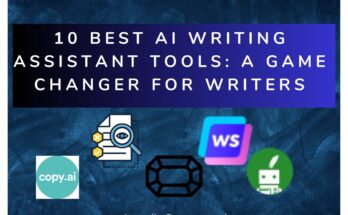In today’s digital landscape, creating compelling ad copy for Google Ads is more important than ever. The right ad copy can make the difference between a user clicking on your ad or scrolling past it. With advancements in technology, Artificial Intelligence (AI) has become a powerful tool to help marketers write persuasive and targeted ad copy that captures attention and drives clicks and conversions. This article will explore how you use AI to craft high-performing How to Write Ads Copy using AI for Google Ads (Get More Clicks & Conversions).
Understanding the Role of Ad Copy in Google Ads
Before diving into how AI can help, it’s essential to understand the role ad copy plays in Google Ads. Your ad copy is the first point of contact with potential customers, so it needs to be compelling, relevant, and persuasive. Effective ad copy should:
The headline and description should catch the user’s eye and make them want to learn more.
Communicate what makes your product or service unique and why the user should choose you.
Use a strong call-to-action (CTA) that encourages users to click on your ad and take the desired action.
Now, let’s see how AI can help you achieve these goals and improve your Google Ads performance.
How AI Can Enhance Your Ad Copywriting
AI tools have revolutionized the way marketers approach ad copywriting. With the ability to analyze data, predict trends, and generate content, AI can help you create ad copy that resonates with your target audience and drives better results. Here’s how AI can assist in writing ad copy for Google Ads:
1. Keyword Optimization
Keywords are the foundation of any Google Ads campaign. AI tools can help you identify the best keywords to target by analyzing search trends, competition, and user intent. Once you have a list of relevant keywords, AI can seamlessly integrate them into your ad copy to ensure it ranks well in search results.
Tools like SEMrush, Ahrefs, or Google’s Keyword Planner can help you find high-performing keywords. AI-driven content generators can incorporate these keywords into your ad copy naturally, without overstuffing.
2. Personalization
AI can analyze user data to create highly personalized ad copy. By understanding your audience’s demographics, preferences, and behavior, AI can tailor your ad copy to speak directly to individual users, increasing the chances of engagement.
AI platforms like Persado or Copy.ai can generate personalized ad copy based on user data. This can include customized headlines, descriptions, and CTAs that align with specific audience segments.
3. A/B Testing at Scale
A/B testing is crucial for determining which version of your ad copy performs best. AI can automate this process by generating multiple variations of your ad copy and testing them simultaneously. This not only saves time but also provides more accurate data on what works.
AI tools like Unbounce or AdEspresso allow you to create and test multiple ad variations quickly. These tools can analyze the results and suggest the best-performing copy for your campaigns.
4. Tone and Emotion Analysis
The tone and emotion conveyed in your ad copy can significantly impact its effectiveness. AI can analyze the emotional appeal of your copy and suggest adjustments to evoke the desired response from your audience.
AI tools like Grammarly or Writesonic can assess the tone of your ad copy and suggest improvements. For example, if your goal is to create urgency, AI can help you craft copy that communicates that emotion effectively.

5. Competitor Analysis
AI can analyze your competitors’ ads to identify what’s working for them. By understanding the strategies that your competitors are using, you can create ad copy that stands out and offers something unique.
Tools like Adthena or SpyFu can help you monitor competitor ad campaigns. AI can then analyze this data to generate ad copy that differentiates your brand while addressing the same audience’s needs.
6. Real-Time Adaptation
One of the most powerful features of AI is its ability to adapt in real time. AI can monitor the performance of your ad copy and make instant adjustments to improve click-through rates (CTR) and conversions.
AI-powered platforms like Google’s Smart Bidding use machine learning to adjust your bids and ad placements in real-time, ensuring your ad copy reaches the right audience at the right time.
Step-by-Step Guide to Writing Google Ads Copy Using AI
Now that we’ve explored the benefits of using AI for ad copywriting, let’s dive into a step-by-step guide on how to use AI to write Google Ads copy that gets more clicks and conversions.
Step 1: Identify Your Campaign Goals
Before you start writing, clearly define what you want to achieve with your Google Ads campaign. Are you looking to drive traffic to your website, increase sales, generate leads, or boost brand awareness? Your campaign goals will guide the tone, content, and structure of your ad copy.
Step 2: Conduct Keyword Research
Use AI-powered tools to conduct thorough keyword research. Identify high-performing keywords that are relevant to your campaign goals and target audience. Ensure these keywords reflect user intent, as this will increase the relevance of your ad copy and improve your Quality Score on Google Ads.
Step 3: Generate Ad Copy with AI
Leverage AI writing tools like Jasper (formerly Jarvis), Copy.ai, or Writesonic to generate ad copy. Input your keywords, audience insights, and any specific messaging you want to include. The AI will generate multiple versions of your ad copy, which you can refine and optimize.
Step 4: Optimize for Personalization
If your campaign targets different audience segments, use AI to personalize your ad copy. Tailor the headlines, descriptions, and CTAs to resonate with each segment. Personalization increases the likelihood of engagement and conversions.
Step 5:Create Variations for A/B Testing
Use AI to create several variations of your ad copy for A/B testing. Ensure that each variation tests a specific element, such as the headline, CTA, or tone. Run these variations simultaneously to gather data on what works best.
Step 6: Monitor Performance and Adapt
Once your ads are live, use AI to monitor their performance in real time. Pay attention to metrics like CTR, conversion rate, and Quality Score. AI can automatically adjust your bids, placements, and even ad copy to optimize performance.
Step 7: Analyze Results and Refine
After running your campaign for a period, analyze the results. Identify which ad copy variations performed best and why. Use these insights to refine your future ad copy, ensuring continuous improvement.
Best Practices for Writing Google Ads Copy with AI
Here are some best practices to keep in mind when using AI to write Google Ads copy:
Keep It Simple:
Google Ads copy should be concise and to the point. Ensure your message is clear and easy to understand.
Use Actionable Language: Encourage users to take action with strong, clear CTAs. Words like “buy,” “shop,” “learn,” and “discover” can be effective.
Focus on Benefits, Not Features: Highlight the benefits your product or service offers the user. What problem does it solve? How will it improve their life?
Test Regularly: Continuously test and refine your ad copy. Even small changes can significantly impact performance.
Stay Compliant: Ensure your ad copy adheres to Google’s advertising policies to avoid disapprovals or penalties.
Conclusion
In 2024, AI will offer a game-changing approach to writing ad copy for Google Ads. By leveraging AI’s capabilities in keyword optimization, personalization, A/B testing, and real-time adaptation, you can create ad copy that not only captures attention but also drives clicks and conversions. As you integrate AI into your ad copywriting process, remember to stay focused on your audience’s needs, continuously test your strategies, and refine your approach based on performance data. With AI as your ally, you’ll be well on your way to running successful Google Ads campaigns that deliver measurable results.



